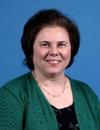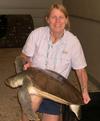Research Terms
Marine Biology Environmental Conservation Natural Resources Conservation Life Sciences Biology Animal Morphology
Keywords
Marine Biology Marine Conservation Sea Turtles Turtles Wildlife & Beaches
Industries
Dr. Jeanette Wyneken is a Professor of Biological Sciences at Florida Atlantic University (FAU) and the Director of the FAU Marine Science Lab. She received her Ph.D. in biology from the University of Illinois. She has more than 40 years of experience studying the biology of reptiles with special emphasis on development, ecology, conservation, and health. Dr. Wyneken has a long history of successful collaborations with other biologists, educators, naturalists, and veterinarians that resulted in more than 100 peer-reviewed publications, 4 books, and 24 book chapters.
Mansfield, KL, J Wyneken, WP Porter & J Luo. 2014. First satellite tracks of neonate sea turtles redefine the “lost years” oceanic niche. The Royal Society Proceeding B. http://dx.doi.org/10.1098/rspb.2013.3039
Perrault, J. R., J.Wyneken, A. Page-Karjian, A. Merrill & D.L. Miller (2014). Seasonal trends in nesting leatherback turtle (Dermochelys coriacea) serum proteins further verify capital breeding hypothesis. Conservation Physiology, 2(1), cou002.
Bovery CM & J Wyneken. 2013. Sea Turtles in Florida’s Atlantic Waters. Marine Fisheries Review.75(3):1-12.
Perrault JR†, DL Miller, J Garner, & J Wyneken. 2013. Mercury and selenium in leatherback sea turtles (Dermochelys coriacea): hazard quotients, population comparisons, implications for hatching success and directions for future research. Science of the Total Environment 463–464 (2013):61–71
Mansfield KL., J.Wyneken, D. Rittschof, M. Walsh, C.W. Lim, P. Richards, 2012. Satellite tag attachment methods for tracking neonate sea turtles. Marine Ecology Progress Series. 457: 181–192
Loggerhead Marinelife Center, Board of Directors; 1991 - present
Sigma Xi, Florida Atlantic University Chapter, Member; - present
Journal of Herpetological Medicine and Surgery, Association of Reptilian and Amphibian Veterinarians; 2005 - 2022
NOAA/NMSF, Sea Turtle Health Assessment; 2003 - 2011
Journal of Experimental Biology
Chelonian Conservation and Biology
Journal of Morphology
Northwest Science
Zoology
Marne Turtle Newsletter
Journal of Experimental Marine Biology and Ecology
Looking at Turtles in Three Dimensions; 20th Symposium for Sea Turtle Biology and Conservation; ; 2000
The Use of CT and Functional MRI to Examine Cardiopulmonary Structure and Function in Ecologically Distinct Species of Turtles; Society for Comparative and Integrative Biology; 2001
Time, Temperature, and Turtles; multiple venues; Osher Life Long Learning; 2023
Time, Temperature, and Turtles; multiple venues; Florida Naturalists; 2024
The Anatomy of Sea Turtles; 28th Annual Sea Turtle Symposium, Brisbane, Queensland Australia; International Sea Turtle Society; 2009
Hawksbill Turtles and Contaminants.; Sea Turtle Contaminant Workshop.; NOAA Fisheries.; 2010
Sex Identification in Neonate Loggerheads, Green Turtles and Leatherbacks by Laparoscopy.; Florida Keys Sea Turtle Workshop. ; HIdden Harbor Turtle Hospital, Marathon, Florida; 2011
Surgical Anatomy of Sea Turtles (Lecture and Wet Lab).; Florida Keys Sea Turtle Workshop. ; HIdden Harbor Sea Turtle Hospital, Marathon, Florida ; 2011
The Travels of Neonate Sea Turtles on the High Seas; Coastal Lecture Series; Florida Oceanographic Society; 2013
Sea Turtles 101; Sea Turtle Symposium; International Sea Turtle Society; 2013
The Renal Portal System and Abdominal Vein; Focus lectures; ARAV; 2002
The Oral Cavity; Focus lectures; ARAV; 2002
The Renal Portal System and Abdominal Vein (with D. Mader); Focus lectures; ARAV; 2002
The leatherback in US Waters; 21st Symposium for Sea Turtle Biology and Conservation; ; 2001
Workshop on the Anatomy of Sea Turtles; 22nd Symposium for Sea Turtle Biology and Conservation; ; 2002
Pulmonary artery structure and function of sea turtles; 22nd Symposium for Sea Turtle Biology and Conservation; ; 2002
A Comparative Approach to Understanding Hatchling Metabolism and its Relationship to Emergence Behavior and Nest Success; 20th Symposium for Sea Turtle Biology and Conservation; ; 2001
The Structure of turtle hearts; In ICVM-8 symposium The reptile 5-chambered heart.; ISVM; 2007
Dr. Jeanette Wyneken is a Professor of Biological Sciences at Florida Atlantic University (FAU) and the Director of the FAU Marine Science Lab. She received her Ph.D. in biology from the University of Illinois. She has more than 40 years of experience studying the biology of reptiles with special emphasis on development, ecology, conservation, and health. Dr. Wyneken has a long history of successful collaborations with other biologists, educators, naturalists, and veterinarians that resulted in more than 100 peer-reviewed publications, 4 books, and 24 book chapters.
Speaker Topics
Animal Tracking Environmental Sex Determination Form and function Hatchling Dispersal Turtle Nests
Target Audiences
Fee Range
Expenses Only Greater than $500 Less than $500 No Cost
Baby sea turtles hatch on their own, dig out of their under ground nests and find the ocean -- all without the help of their mother or father. Once they leave the beach the high seas become their nursery. Where do they go? This lecture covers both the process of how to answer the question and the results of our innovative studies tracking neonate sea turtles with satellites for weeks to months to find out where they go to grow.
Subject Areas:
Keywords:
Audience:
Adults
Duration:
1 hour or less
Fee:
Expenses Only
An intriguing aspect of sea turtles is that they have environmentally determined sex (no X or Y chromosomes like in people or other mammals). Because of this key trait, most populations of sea turtles produce strongly females-biased clutches. So where do the boys come from? This mystery is solved through a combination of basic science, understanding, accessible modeling and the history of turtles.
Subject Areas:
Keywords:
Audience:
Adults
Duration:
1 hour or less
Fee:
Expenses Only



















Florida Atlantic University 777 Glades Rd SC136 Boca Raton, Florida 33431

